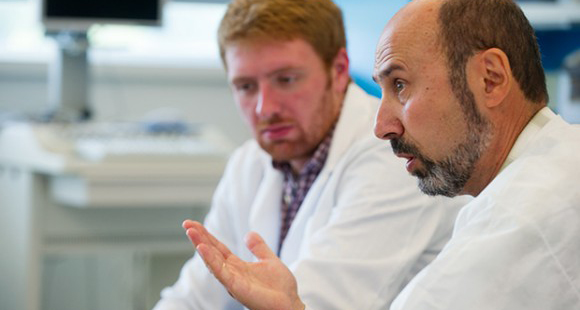Imagine a device so small it can be embedded in your t-shirt — a device that non-invasively and painlessly monitors your heart’s electrical signals, predicting dangerous cardiac arrhythmias. Dr. Joseph Starobin did.
Starobin, associate professor of nanoscience in UNCG and NC A&T’s Joint School of Nanoscience and Nanoengineering, and his team — a postdoctoral researcher and two doctoral students — are currently developing the tiny electrocardiographic device. Starobin believes it can save lives, lower healthcare costs and pose less risk to patients.
“Ideally, this device will allow doctors to catch heart abnormalities at pretty early stages,” he says. “Without miniaturized devices, one can’t catch these problems before symptoms appear.”
Starobin’s team doesn’t have a completed prototype yet, but he expects to have one within the next two years. Starobin worked closely with doctors and biomedical engineers at Duke Medical Center’s electrophysiological catheterization lab to compare recordings of electrical signals done through invasive methods with surface measures.
Currently, he says, EKG’s and catheterization are the only options for diagnosis and monitoring of arrhythmias. The EKG T-Wave Alternans, a non-invasive method where large electrodes are placed on the patient and signals are recorded by a large machine, catches only specific waves.
Catheterization, an invasive procedure performed by specialists, can cost $10,000-$15,000 — not always an option for patients without good health insurance.
“The invasive procedures are very costly,” Starobin explains. “The EKG T-Wave Alternans technology paves the road, but still the road is bumpy.”
Starobin says many cardiac arrhythmias are caused when a heart attack scars or weakens the heart muscle, preventing the healthy movement of electrical waves through that muscle. Athletes — who may develop very large heart muscle — are also at risk.
Starobin’s device would be helpful in monitoring post-heart attack patients and athletes. They could wear the device during periods of recovery or high activity, and their doctors could study electrical signals remotely.
The electrical capacitor, which utilizes several hundred-nanometer-thin gold film as electrodes, should be as effective as an invasive procedure at finding problems, Starobin says. And it will power itself by harvesting the heart’s electrical energy.
Story by Michelle Hines, University Relations
